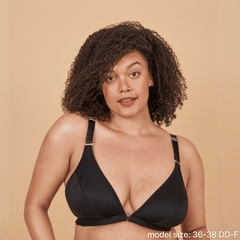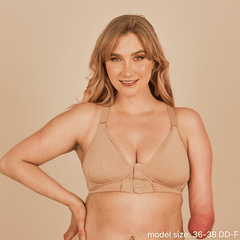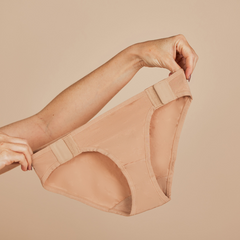We all want to look and feel our best in front of others, even when our normal routines are interrupted. For those planning ahead for major surgery, it can be intimidating to think about how your routine schedule and daily activities will get back on track, including everyday things like getting dressed.

An estimated 48 million inpatient surgeries are performed each year in the United States. It is also possible that one person might experience surgery a few times in life; one study estimates that the average American will have about 3 inpatient operations during their lifetime.
If you are preparing for an upcoming surgery, it helps to plan ahead and think through everything you might need afterward. This includes your personal care and dressing routine.
What you look like after a surgery can be a particularly sensitive issue for some, since it can bring feelings of embarrassment or reliance on others for simple acts of getting ready in the morning. Of course, there is nothing to be ashamed of if you are not completely ‘put together’ after a surgery, but it may also help you feel confident and independent to prepare in advance for your wardrobe and appearance post-surgery.
Looking your best might help you recuperate from major surgery by giving you a psychological boost. Clothing options may be limited, particularly after abdominal or limb surgery since these are the areas that move around most when we get dressed. Ask your doctor about the expected level of movement you will have after surgery, and plan ahead for wardrobe requirements while you are still independent and mobile.
If possible, shop for your own postoperative attire before surgery to have some influence over your wardrobe selections, rather than sending a family member or caretaker to handle it later. (They may not choose the precise color or design that you like, anyway.)
Unexpected surgery happens from time to time. If you have been caught off guard, there are many online shops and mail order catalogs with home delivery to give you convenience and variety.
What is ‘adaptive clothing’?
Adaptive apparel is clothing created particularly for persons with limited mobility who have trouble dressing themselves independently, or who have sensory difficulties with certain textures and materials. Adaptive clothing incorporates elements such as Velcro closures, one-handed zippers, wider necklines, adjustable pant hems, and magnetic buttons to make dressing simpler while maintaining a typical appearance on the outside.
Importantly, adaptive clothing can be for long-term or temporary mobility limitations. Many people are now choosing to shop for adaptive clothing after a surgery or broken limb, in order to maintain outward style despite temporary needs.
After surgery, adults may need customizations in order to allow for medical ports, bandages, or slings. Post-surgery adaptive clothing often includes hidden flaps or zippers to allow for openings, loose soft fabric for comfort, and hidden pockets to store tubing or a battery pack.

What should I wear right after surgery?
For inpatient surgeries, it helps to bring comfortable clothes and supplies for a few days just in case.
A standard packing checklist when it comes to your wardrobe includes:
-
Loose-fitting clothing, ideally with wide waistbands
-
Cotton underwear with loose waistband
-
Socks, ideally fuzzy or extra comforting
-
Nightgown or pajamas
-
Slippers
-
Robe
- If you use glasses or contact lenses, you'll need a case and supplies
Remember that your body will experiencing swelling, so loose-fitting clothes in a rigid material may not fit. Stretchy materials are best. Even elastic waistbands might be unpleasant unless they are quite stretched out.
Wear loose-fitting clothes to the hospital, and do not bring fitted clothes or clothing with zippers, buttons, or hooks. You may feel low-energy after surgery, so these extra fasteners can be inconvenient. A loose dress, loose sweater, and loose sweatpants with drawstrings may be most comfortable in case you experience a higher degree of swelling or restricted movement.
Some common mistakes people make while going for inpatient surgery including bringing valuable/breakable items, electrical appliances such as coffeepots or fans, candles or anything with an open flame, and restrictive clothing requiring movement/twisting to put on.
Ongoing recovery from home
Whether your recovery period is just a few weeks or a few months, do your best not to just stay in your pajamas or robe all day. Getting dressed and appearing ‘put together’ can work wonders for making you feel more awake, energized, and open to interaction.
Cotton underwear will be softer and more breathable, especially a style with either just one or no seams. Buy a size larger than you might normally wear to account for swelling or bandages. It is a good idea to ask your doctor in advance where your incisions will be, so that you can find underwear with a style that avoids the area. For example, a low-cut bikini style underwear is useful for waistline incisions (such as after a C-section), while full coverage or shorts style underwear may be useful otherwise. Don’t be afraid to look in the maternity section for loose, comfortable styles.
If you would like to wear a bra during recovery, be sure to find one specifically designed for adaptive use. Traditional bras tend to be tight around the chest, and back-closure bras may require more twisting and arm movement than is comfortable. Springrose’s adaptive bra, for example, specifically employs adjustable wide straps, a front closure, no underwire, and extra soft material. This can make it easier to put a bra on while laying down, sitting, or standing, depending on which positions are comfortable during your recovery.
Clothes should still be loose and comfortable, like crew pants or stretchy yoga pants, with waistline flexibility. Pants or skirts with a smooth band in the front and elastic in the rear may be more comfortable than those with a completely elastic waistband. Look for a wide band so that it does not dig into your midsection while sitting.
Temporarily, garments that open down the front or side may be easier, so that you do not need to deal with clasps behind the back or lift your arms to much to insert into arm holes. Sweaters/shirts that open at the shoulder or all the way down the side of the body may be easier to get into than over-the-head clothes.
Consider apparel that isn't prone to wrinkles. While recovering, rest and naps are essential. Knitted or polyester-blend clothes tend to have fewer creases and appear fresher even if you are taking naps throughout the day.
It's crucial to be comfortable during recuperation, but it's also psychologically beneficial to look your best. Although the body may not be back to normal yet, "appearing normal" is a good trick to feel better and get back to your routine sooner. Besides, you'll need some clothing for doctor's appointments, brief trips outside to stomp out "cabin fever," and to feel confident when guests come by to wish you well. Plan ahead of time so that you can keep at least one aspect of your life under control during a period of uncertainty—your personal style.




